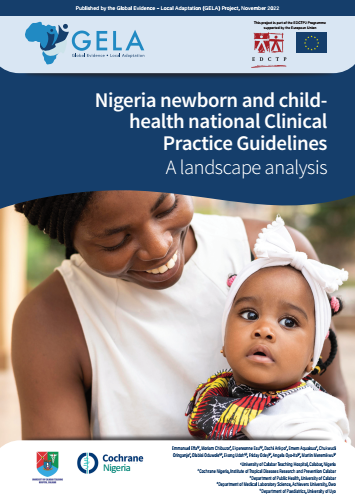Executive summary

Worldwide, there has been progress towards the attainment of child-health targets of Sustainable Development Goal 3.2 – end preventable deaths of newborns and children under five years of age by 2030 – by aiming to reduce the neonatal mortality rates to at least 12 per 1000 live births and under-five mortality rates to at least 25 per 1000 live births. This progress has been suboptimal in sub-Saharan Africa with the risk of not achieving these targets. Evidence-informed clinical practice guidelines (CPGs) are demonstrably cost effective and improve clinical and population health outcomes. To optimise healthcare delivery especially in poorly resourced countries, the World Health Organization (WHO) has either led or supported the development of CPGs for leading causes of deaths in newborns and children especially infectious and other poverty related diseases. Although evidence-informed healthcare practice has been growing in subSaharan Africa (SSA) and methodological guidance for CPG development by the WHO exists, CPGs in sub-Saharan Africa do not always meet standards for reporting and often perform poorly in terms of their rigour of development and editorial independence. In addition, the adaptation of such guidelines and recommendations to national contexts is not well described. In Nigeria, it is unclear the extent to which newborn and child health CPGs are available, evidence informed and developed using standard methodology as recommended by the WHO. The Global Evidence, Local Application (GELA) project is a collaborative multi-country project.
It undertook to: i) assess the current landscape of newborn and child-health CPGs in Nigeria over the past five years; ii) critically appraise the quality and reporting standards using the AGREE II tool; and, iii) identify gaps and plan to implement capacity building and dissemination activities for relevant key stakeholders in the country.
Several approaches were used to identify relevant national guidelines including website searches of international, national and sub-national agencies, personal contacts and reference lists of included guidelines. Identified CPGs were screened using a pre-determined eligibility tool, data were extracted and an analysis done. A total of 655 records were retrieved of which 46 full texts were retrieved. Eleven guidelines were included in the analysis. Overall, the CPG development process in Nigeria is predominantly driven by the Federal Ministry of Health with most of the CPGs directed at primary, secondary and tertiary levels of care. The majority of the CPGs focused on infants and young children, and targeted health practitioners for their implementation. Newborn care and HIV prevention and treatment were the top conditions addressed, and the quality of the CPGs was generally limited by poor rigour of development, applicability, and editorial independence. Adapted guidelines were associated with higher quality scores from the AGREE II appraisal compared to de novo guidelines. Notably, there were few guidelines targeting poverty-related diseases and none focusing on public-health interventions. Given the timeline limitation of five years, this may not be a full reflection of the extent of the landscape of CPGs in the area of newborn and child health in Nigeria. Nonetheless, this baseline analysis should inform future interventions in Nigeria’s CPG ecosystem.
Current efforts and interest in CPG development in the context of the achievement of Sustainable Development Goal 3.2 need to be expanded to include relevant poverty-related diseases that drive morbidity and mortality in newborn and child health in Nigeria. Prioritisation of newborn and young child-health conditions using evidence-based methods that feed into the CPG process will need to be more rigorous. Other key stakeholders will need to be involved in the process, and guideline development methodology improved upon with the Federal Ministry of Health acting as a clearinghouse.
Click here to read the full report of the landscape analysis.
